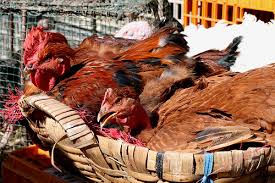Rural poultry marketing systems and associated marketing constraints in two agro-ecological zones of central Tigray, Northern Ethiopia
Keywords:
Chicken, Plumage, Marketing, Demand, SupplyAbstract
A study on rural poultry marketing was conducted in lowland and midland agro-ecological zones of central Tigray, in northern Ethiopia with the objective of characterization of rural poultry marketing system under rural household management. A total of 160 rural households, 80 from each district, were randomly selected and 50% of them were female headed households. Data were collected using semi structured questionnaire and group discussion with key informants and traders. Twenty seven chicken and egg traders and 60 consumers were also randomly selected and interviewed to collect market information. All age group of chickens except chicks (< 2 months) were sold at market but cocks and cockerels take the largest proportion. The total number of live birds and eggs sold per households per year was significantly greater (P<0.0001) in midland than in lowland. Chicken and egg selling was also significantly greater (P<0.01) in female headed households than in male headed households. Chickens with red plumage color were dominant in the market covers 56.2% of the total chickens. Average numbers of birds and eggs sold per household per year were 4.3 and 48.75 in lowland and 6.2 and 81.25 in midland, respectively. Mean price of matured and grower chickens was 49.96 birr and 35.3 birr in lowland and 51.3 birr and 39.7 birr in midland, respectively, and average price of eggs was 1.3 birr in lowland and 1.4 birr in midland agro-ecology. Average price of chickens and eggs in lowland areas was significantly (P<0.0001) lower than average price in midland agro-ecological zone of the study area. There was also a significant difference (P<0.0001) in price of chicken products between ordinary market days and festival market days. Price of double comb cocks was significantly greater (P<0.0001) than price of single comb cocks. Chicken and egg traders collect chickens and eggs from producers at farm gets, road sides and different local or urban markets. In turn 87.8% of the collected chickens and 74.9% of the collected eggs were sold to direct consumers. Lack of extension service for indigenous ecotypes, lack of appropriate market place and seasonality of market prices in both agro-ecologies were the main constraints of rural poultry marketing in the study area. Therefore, separate market place and appropriate poultry extension and credit packages should be designed to improve rural poultry marketing in both agro-ecologies.
References
Abdelqader, A., Wollny, C., Gauly, M., 2007. Characterization of local chicken production systems and their
potential under different levels of management practice in Jordan. Journal of Trop Anim Health Prod, 39,155–
Aklilu, H.A., Almekinders, C.J.M., Udo, H.M.J., Van der Zijpp, A.J., 2007. Village poultry consumption and marketing
in relation to gender, religious festivals and market access. Trop Anim Health Prod. 39,165–177.
Australian Agricultural Consulting and Management Company (AACMC), 1984. Livestock sub sector review, Volume
, Annex 3.
Central Statistical Agency , 2007. National census of Ethiopia.
Dessie, T., Ogle, B., 2001. Village poultry production system in the central high lands of Ethiopia. J. Tropical Animal
Health and Production, 33, 521-537.
Farooq, M., Shakir, M.K., Mian, M.A., Mussawar, S., Durrani, F.R., Cheema, A., 2004. Status of backyard chicken
reared by women in chitral, Pakistan. Pakistan Vet. J., 24, 82-86.
Farooq, M., Mian M.A., 2001. Contribution of backyard chicken to household economy produced by non member
and member farmers of Women In Development (WID) under Sarhad Rural Support Program (SRSP) in
Charsadda, Pakistan. J. Rural Development, 33, 89-97.
Fisseha, M., Abera, M. and Tadelle D., 2010. Assessment of village chicken production system and evaluation of the
productive and reproductive performance of local chicken ecotype in Bure district, North west Ethiopia.
African Journal of Agricultural Research Vol. 5, 1739-1748.
Halima, H., Neser, F., Van Marle-Koster, E., De Kock, A., 2007. Village-based indigenous chicken production system
in north-west Ethiopia. Journal of Tropical Animal Health and Production, 39,189–197.
Kibret, B., 2008. In situ characterization of local chicken eco-type for functional traits and production system in
Fogera Woreda, Amhara Rgional State. International Livestock Research Institute (ILRI)
http://mahider.ilri.org/handle/10568/679.
SAS Institute Inc., 2002. JMP-5 Statistical Software, Version 5.Cary, NC, USA.
Tadelle, D., Million, T., Alemu, Y., Peters K.J., 2003. Village chicken production systems in Ethiopia: Use patterns
and performance valuation and chicken products and socio-economic functions of chicken. Livestock
Research for Rural Development 15 (1).
Tadelle, D., Peter, K.J., 2003. Indigenous chicken in Ethiopia: neglected but worth the cost of conservation through
improved utilization. Humboldt University of Berlin.

Downloads
Published
How to Cite
Issue
Section
License
Copyright (c) 2013 A. T. Atsbeha, G. T. Yayneshet

This work is licensed under a Creative Commons Attribution-NonCommercial-NoDerivatives 4.0 International License.



